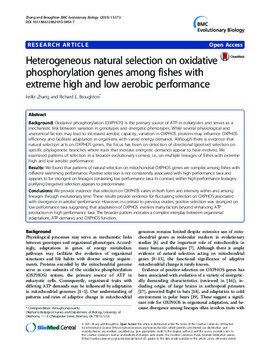| dc.contributor.author | Zhang, Feifei | |
| dc.contributor.author | Broughton, Richard E. | |
| dc.date.accessioned | 2015-10-08T19:06:12Z | |
| dc.date.accessioned | 2016-03-30T15:33:24Z | |
| dc.date.available | 2015-10-08T19:06:12Z | |
| dc.date.available | 2016-03-30T15:33:24Z | |
| dc.date.issued | 2015-08-26 | |
| dc.identifier.citation | Zhang and Broughton BMC Evolutionary Biology (2015) 15:173 DOI 10.1186/s12862-015-0453-7 | en_US |
| dc.identifier.uri | https://hdl.handle.net/11244/19494 | |
| dc.description.abstract | Background: Oxidative phosphorylation (OXPHOS) is the primary source of ATP in eukaryotes and serves as a mechanistic link between variation in genotypes and energetic phenotypes. While several physiological and anatomical factors may lead to increased aerobic capacity, variation in OXPHOS proteins may influence OXPHOS efficiency and facilitate adaptation in organisms with varied energy demands. Although there is evidence that natural selection acts on OXPHOS genes, the focus has been on detection of directional (positive) selection on specific phylogenetic branches where traits that increase energetic demands appear to have evolved. We examined patterns of selection in a broader evolutionary context, i.e., on multiple lineages of fishes with extreme high and low aerobic performance.
Results: We found that patterns of natural selection on mitochondrial OXPHOS genes are complex among fishes with different swimming performance. Positive selection is not consistently associated with high performance taxa and appears to be strongest on lineages containing low performance taxa. In contrast, within high performance lineages, purifying (negative) selection appears to predominate.
Conclusions: We provide evidence that selection on OXPHOS varies in both form and intensity within and among lineages through evolutionary time. These results provide evidence for fluctuating selection on OXPHOS associated with divergence in aerobic performance. However, in contrast to previous studies, positive selection was strongest on low performance taxa suggesting that adaptation of OXPHOS involves many factors beyond enhancing ATP production in high performance taxa. The broader pattern indicates a complex interplay between organismal adaptations, ATP demand, and OXPHOS function. | en_US |
| dc.description.sponsorship | This work was supported by NSF award DEB-0732988 (to REB). | en_US |
| dc.language | en_US | en_US |
| dc.relation.uri | http://www.biomedcentral.com/1471-2148/15/173 | |
| dc.subject | marine biology | en_US |
| dc.title | Heterogeneous natural selection on oxidative phosphorylation genes among fishes with extreme high and low aerobic performance | en_US |
| dc.type | Article | en_US |
| dc.description.peerreview | Yes | en_US |
| dc.identifier.doi | 10.1186/s12862-015-0453-7 | en_US |
| ou.group | College of Arts and Sciences::Department of Biology | en_US |
